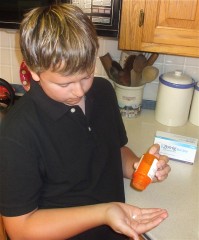
Researchers at Nationwide Children’s Hospital say parents may not realize school really can be a headache for kids like Peyton (pictured above).
More than a third of children suffer from recurrent headaches – headaches that occur more than once a month. Most are tension headaches, which are less severe and do not occur with nausea or vomiting. Migraines, which account for approximately 25 percent of headaches, are much more disruptive and frequently occur within families due to a genetic component. Migraine pain is usually characterized as throbbing or pounding and made worse by physical activity. Pediatricians typically see an increase in migraine patients as the more severe pain and nausea can cause students to miss school and other daily activities.
“Try to get your kids back into a routine schedule at least two weeks before school starts,” advises Ann Pakalnis, MD, neurologist at Nationwide Children’s Hospital. “Begin enforcing earlier bedtimes, and make sure children are well-rested before beginning a new school year.”
In a new study published in Headache this year, researchers at Nationwide Children’s Hospital found that sleep and emotional disorders were common in adolescents with migraines. Sleep disorders and mild, chronic depression became more common as headaches became more frequent. Researchers also found that all participants who regularly consumed caffeine generally reported more depression and were poorer sleepers.
“Our study indicates that patients with migraines should be monitored for sleep and emotional disorders,” said Dr. Pakalnis, also a faculty member at The Ohio State University College of Medicine. “These findings suggest that factors such as frequent migraines may play a role in the occurrence of these disorders. Also, minimizing caffeine consumption may benefit sleep and mood in headache patients and decrease susceptibility to migraine attacks.”
In addition to making sure kids get plenty of sleep and minimize caffeine intake, parents should ensure their children are eating balanced meals and snacks regularly. Also, limit their caffeine intake and monitor to check that they are getting the proper amount of fluids.
Over-the-counter medicines can provide relief but are sometimes difficult for children to swallow or digest, particularly if they have a migraine accompanied by nausea. Newer therapies such as triptans which work on the brain’s serotonin system are very specific for migraine treatment. Although there are multiple medications in this class, only one has been approved by the FDA for use in adolescents. Parents should also monitor the amount of over-the-counter analgesics older adolescents are taking, such as ibuprofen and acetaminophen. Using these medications for headaches several times a week could be a sign of a more severe condition and lead to more adverse effects which make it more difficult to manage pain.
Children who still have frequent headaches or migraines, despite a healthy lifestyle and regular schedule, should consult their pediatrician. A doctor visit is also recommended if the child’s headaches occur in the back of the head, rather than the front or side of the head, or if headaches occur only in the morning, result in nausea, get progressively worse over time or suddenly deviate from their existing pattern. These could all be signs of a more serious condition or may require additional treatment.
Source: Nationwide Childrens Hospital
